Lexus GS300h 2013 Owner's Manual
Manufacturer: LEXUS, Model Year: 2013, Model line: GS300h, Model: Lexus GS300h 2013Pages: 1014
Page 921 of 1014
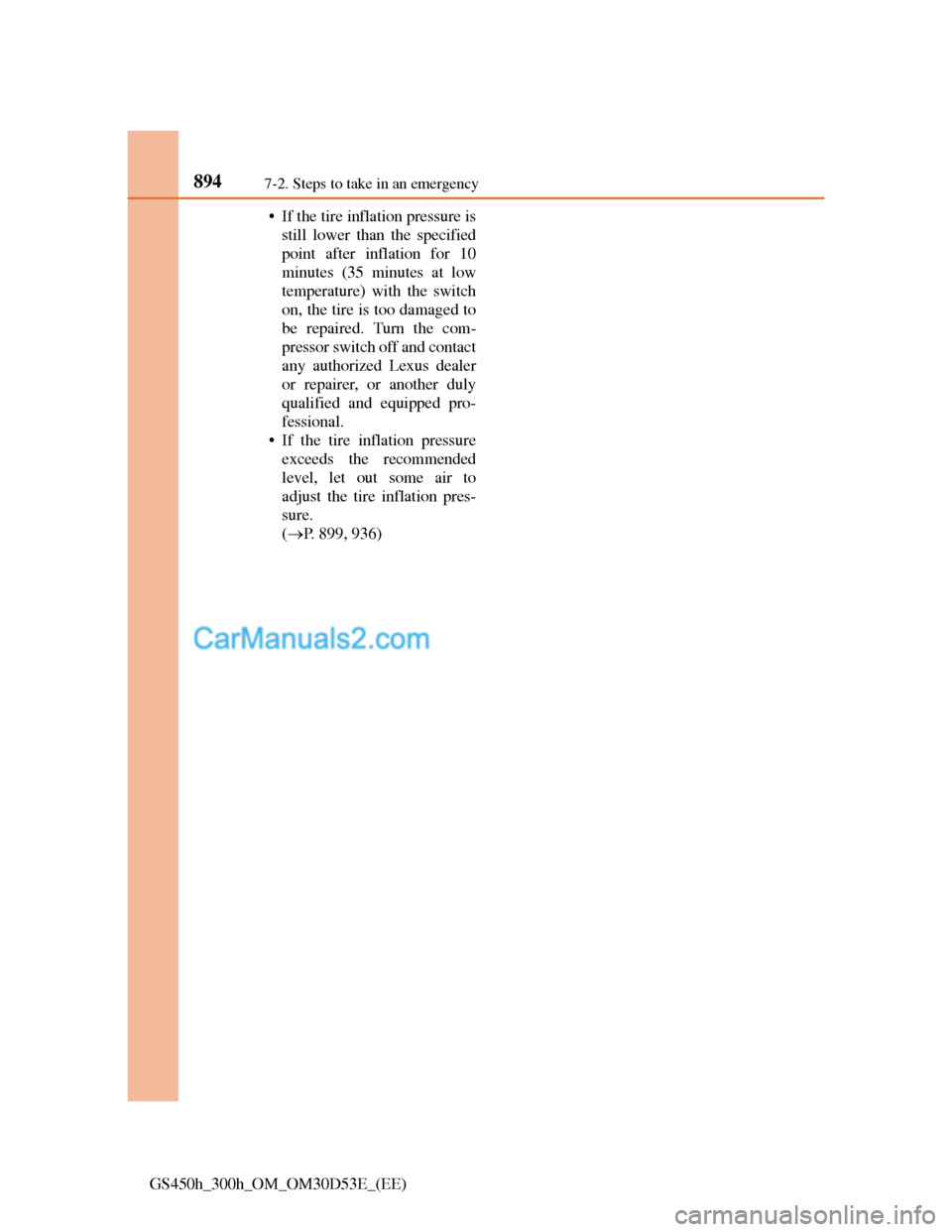
8947-2. Steps to take in an emergency
GS450h_300h_OM_OM30D53E_(EE)• If the tire inflation pressure is
still lower than the specified
point after inflation for 10
minutes (35 minutes at low
temperature) with the switch
on, the tire is too damaged to
be repaired. Turn the com-
pressor switch off and contact
any authorized Lexus dealer
or repairer, or another duly
qualified and equipped pro-
fessional.
• If the tire inflation pressure
exceeds the recommended
level, let out some air to
adjust the tire inflation pres-
sure.
(P. 899, 936)
Page 922 of 1014
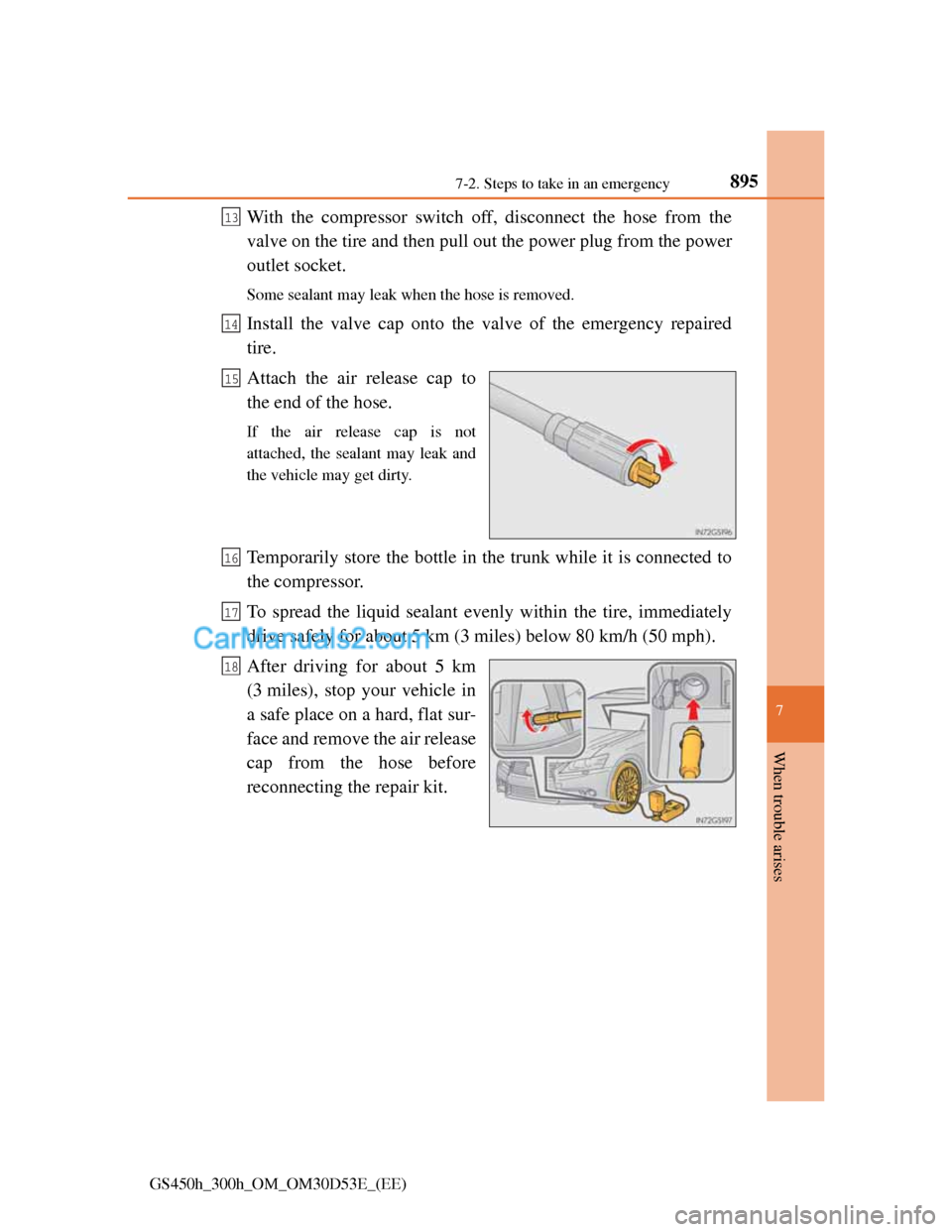
8957-2. Steps to take in an emergency
7
When trouble arises
GS450h_300h_OM_OM30D53E_(EE)
With the compressor switch off, disconnect the hose from the
valve on the tire and then pull out the power plug from the power
outlet socket.
Some sealant may leak when the hose is removed.
Install the valve cap onto the valve of the emergency repaired
tire.
Attach the air release cap to
the end of the hose.
If the air release cap is not
attached, the sealant may leak and
the vehicle may get dirty.
Temporarily store the bottle in the trunk while it is connected to
the compressor.
To spread the liquid sealant evenly within the tire, immediately
drive safely for about 5 km (3 miles) below 80 km/h (50 mph).
After driving for about 5 km
(3 miles), stop your vehicle in
a safe place on a hard, flat sur-
face and remove the air release
cap from the hose before
reconnecting the repair kit.
13
14
15
16
17
18
Page 923 of 1014
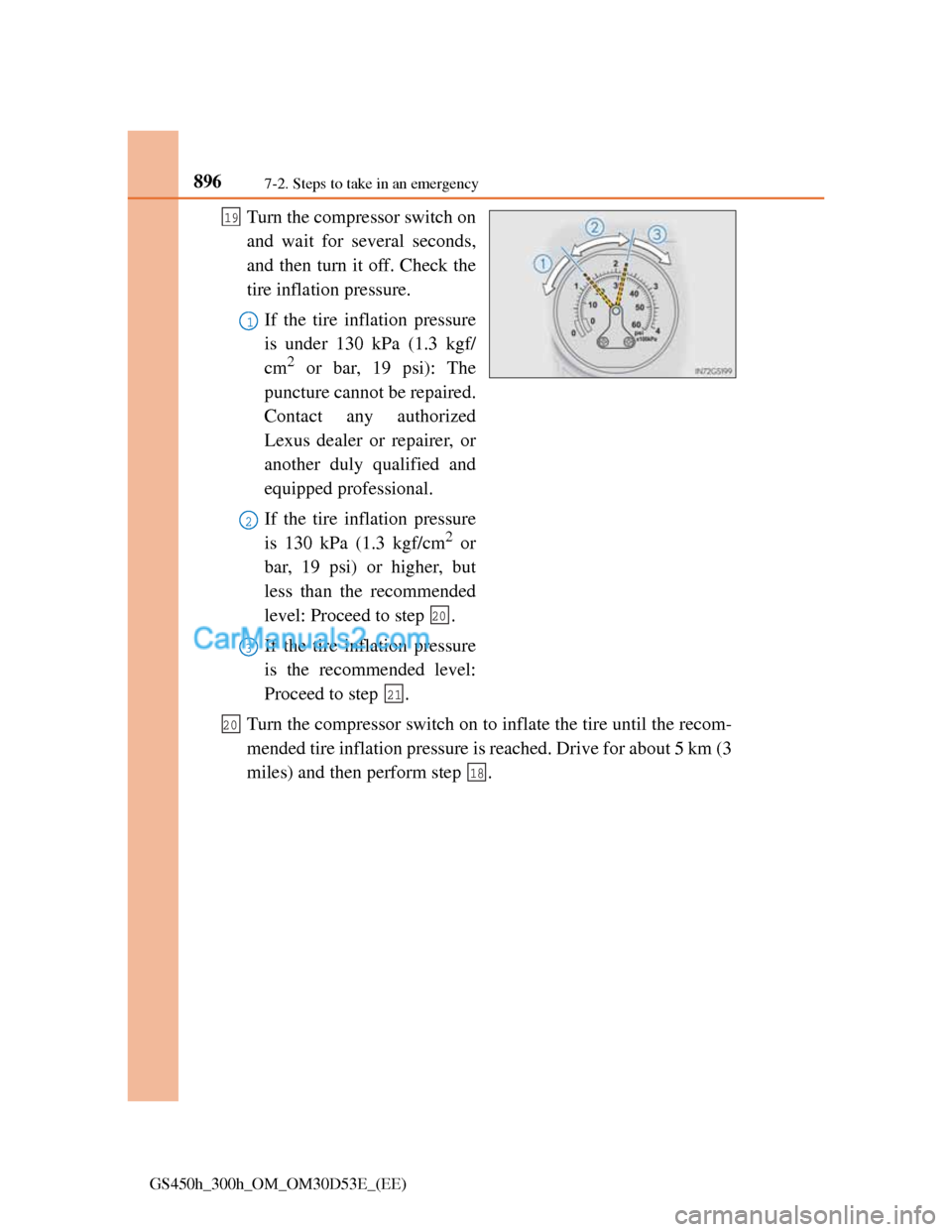
8967-2. Steps to take in an emergency
GS450h_300h_OM_OM30D53E_(EE)
Turn the compressor switch on
and wait for several seconds,
and then turn it off. Check the
tire inflation pressure.
If the tire inflation pressure
is under 130 kPa (1.3 kgf/
cm
2 or bar, 19 psi): The
puncture cannot be repaired.
Contact any authorized
Lexus dealer or repairer, or
another duly qualified and
equipped professional.
If the tire inflation pressure
is 130 kPa (1.3 kgf/cm
2 or
bar, 19 psi) or higher, but
less than the recommended
level: Proceed to step .
If the tire inflation pressure
is the recommended level:
Proceed to step .
Turn the compressor switch on to inflate the tire until the recom-
mended tire inflation pressure is reached. Drive for about 5 km (3
miles) and then perform step .
19
1
2
20
3
21
20
18
Page 924 of 1014
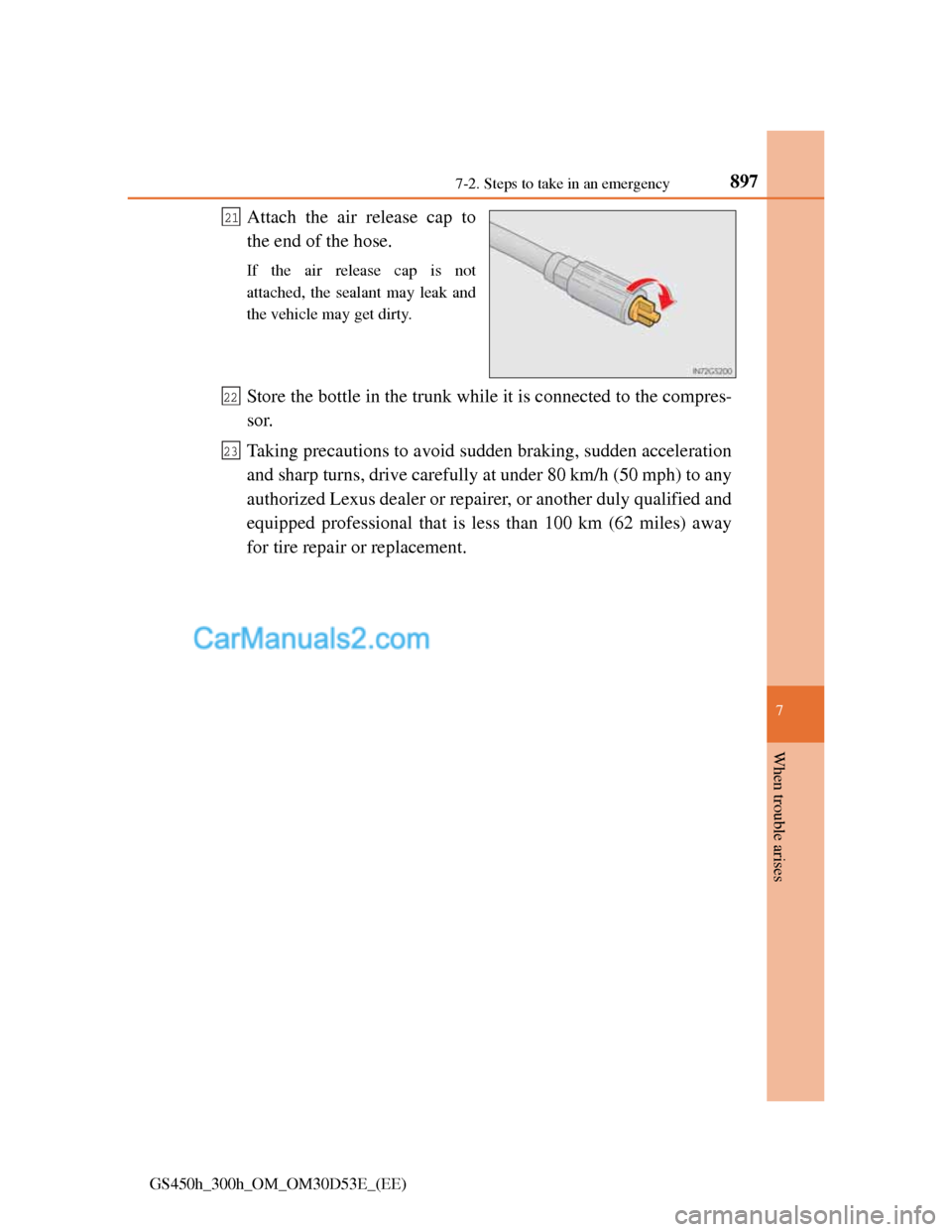
8977-2. Steps to take in an emergency
7
When trouble arises
GS450h_300h_OM_OM30D53E_(EE)
Attach the air release cap to
the end of the hose.
If the air release cap is not
attached, the sealant may leak and
the vehicle may get dirty.
Store the bottle in the trunk while it is connected to the compres-
sor.
Taking precautions to avoid sudden braking, sudden acceleration
and sharp turns, drive carefully at under 80 km/h (50 mph) to any
authorized Lexus dealer or repairer, or another duly qualified and
equipped professional that is less than 100 km (62 miles) away
for tire repair or replacement.
21
22
23
Page 925 of 1014
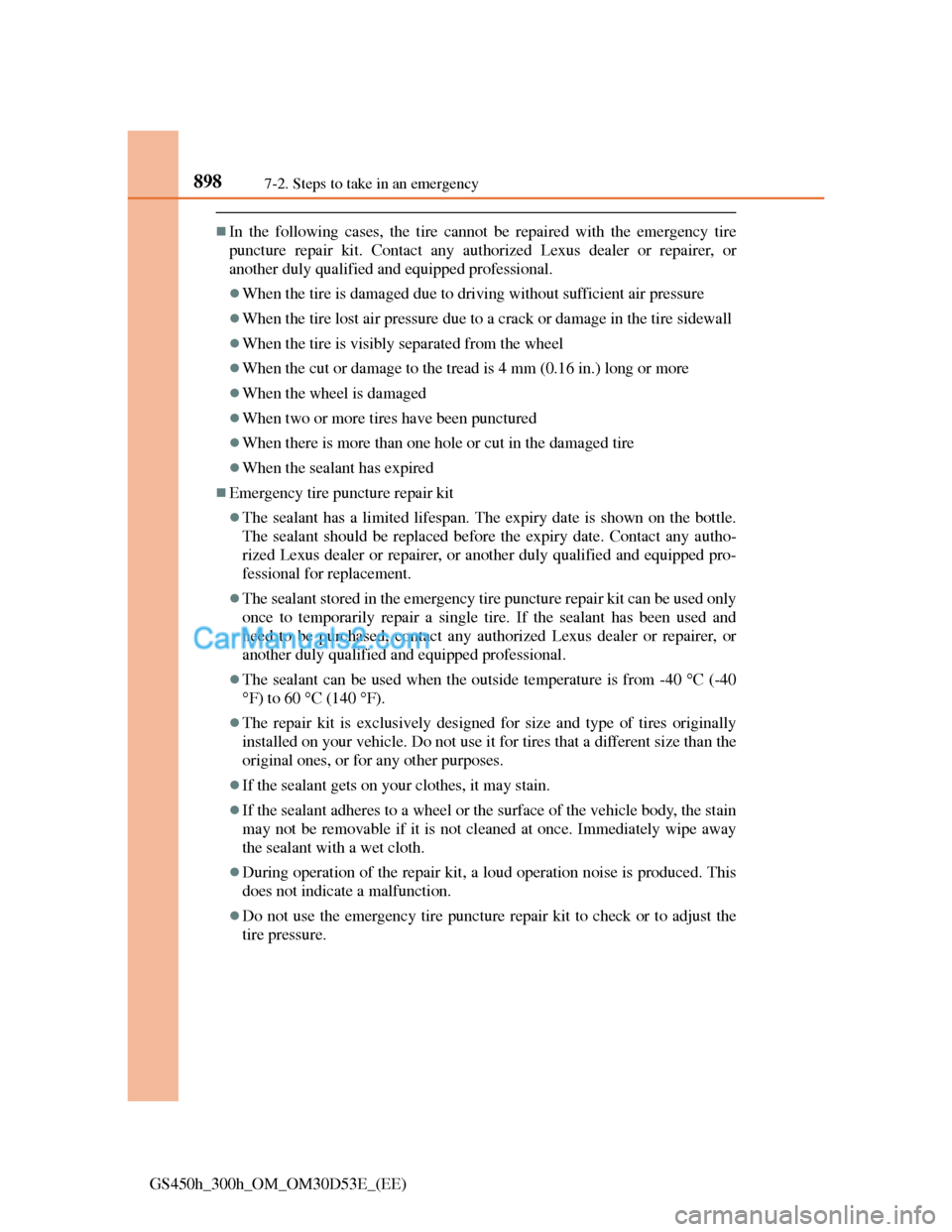
8987-2. Steps to take in an emergency
GS450h_300h_OM_OM30D53E_(EE)
In the following cases, the tire cannot be repaired with the emergency tire
puncture repair kit. Contact any authorized Lexus dealer or repairer, or
another duly qualified and equipped professional.
When the tire is damaged due to driving without sufficient air pressure
When the tire lost air pressure due to a crack or damage in the tire sidewall
When the tire is visibly separated from the wheel
When the cut or damage to the tread is 4 mm (0.16 in.) long or more
When the wheel is damaged
When two or more tires have been punctured
When there is more than one hole or cut in the damaged tire
When the sealant has expired
Emergency tire puncture repair kit
The sealant has a limited lifespan. The expiry date is shown on the bottle.
The sealant should be replaced before the expiry date. Contact any autho-
rized Lexus dealer or repairer, or another duly qualified and equipped pro-
fessional for replacement.
The sealant stored in the emergency tire puncture repair kit can be used only
once to temporarily repair a single tire. If the sealant has been used and
need to be purchased, contact any authorized Lexus dealer or repairer, or
another duly qualified and equipped professional.
The sealant can be used when the outside temperature is from -40 C (-40
F) to 60 C (140 F).
The repair kit is exclusively designed for size and type of tires originally
installed on your vehicle. Do not use it for tires that a different size than the
original ones, or for any other purposes.
If the sealant gets on your clothes, it may stain.
If the sealant adheres to a wheel or the surface of the vehicle body, the stain
may not be removable if it is not cleaned at once. Immediately wipe away
the sealant with a wet cloth.
During operation of the repair kit, a loud operation noise is produced. This
does not indicate a malfunction.
Do not use the emergency tire puncture repair kit to check or to adjust the
tire pressure.
Page 926 of 1014
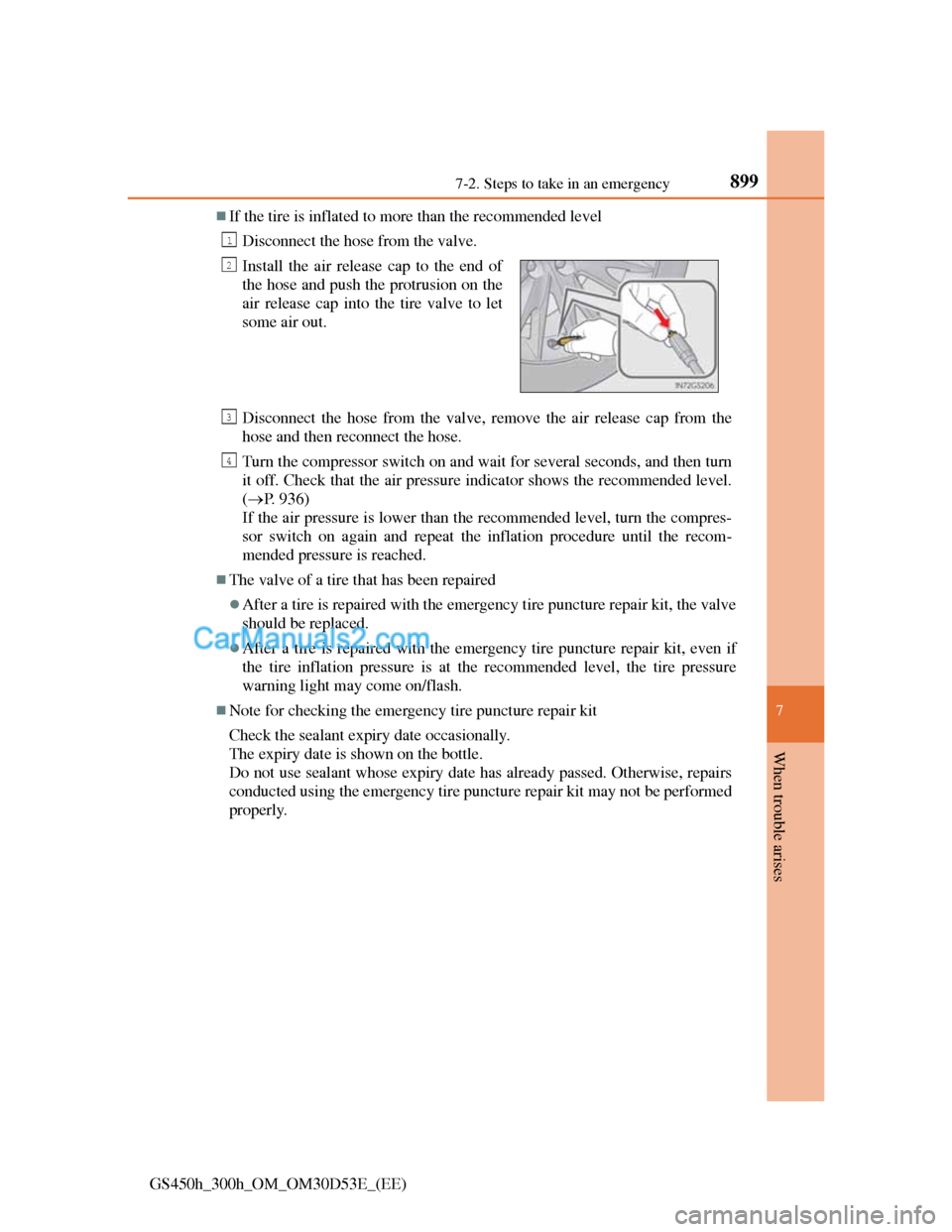
8997-2. Steps to take in an emergency
7
When trouble arises
GS450h_300h_OM_OM30D53E_(EE)
If the tire is inflated to more than the recommended level
Disconnect the hose from the valve.
Disconnect the hose from the valve, remove the air release cap from the
hose and then reconnect the hose.
Turn the compressor switch on and wait for several seconds, and then turn
it off. Check that the air pressure indicator shows the recommended level.
(P. 936)
If the air pressure is lower than the recommended level, turn the compres-
sor switch on again and repeat the inflation procedure until the recom-
mended pressure is reached.
The valve of a tire that has been repaired
After a tire is repaired with the emergency tire puncture repair kit, the valve
should be replaced.
After a tire is repaired with the emergency tire puncture repair kit, even if
the tire inflation pressure is at the recommended level, the tire pressure
warning light may come on/flash.
Note for checking the emergency tire puncture repair kit
Check the sealant expiry date occasionally.
The expiry date is shown on the bottle.
Do not use sealant whose expiry date has already passed. Otherwise, repairs
conducted using the emergency tire puncture repair kit may not be performed
properly.Install the air release cap to the end of
the hose and push the protrusion on the
air release cap into the tire valve to let
some air out.
1
2
3
4
Page 927 of 1014
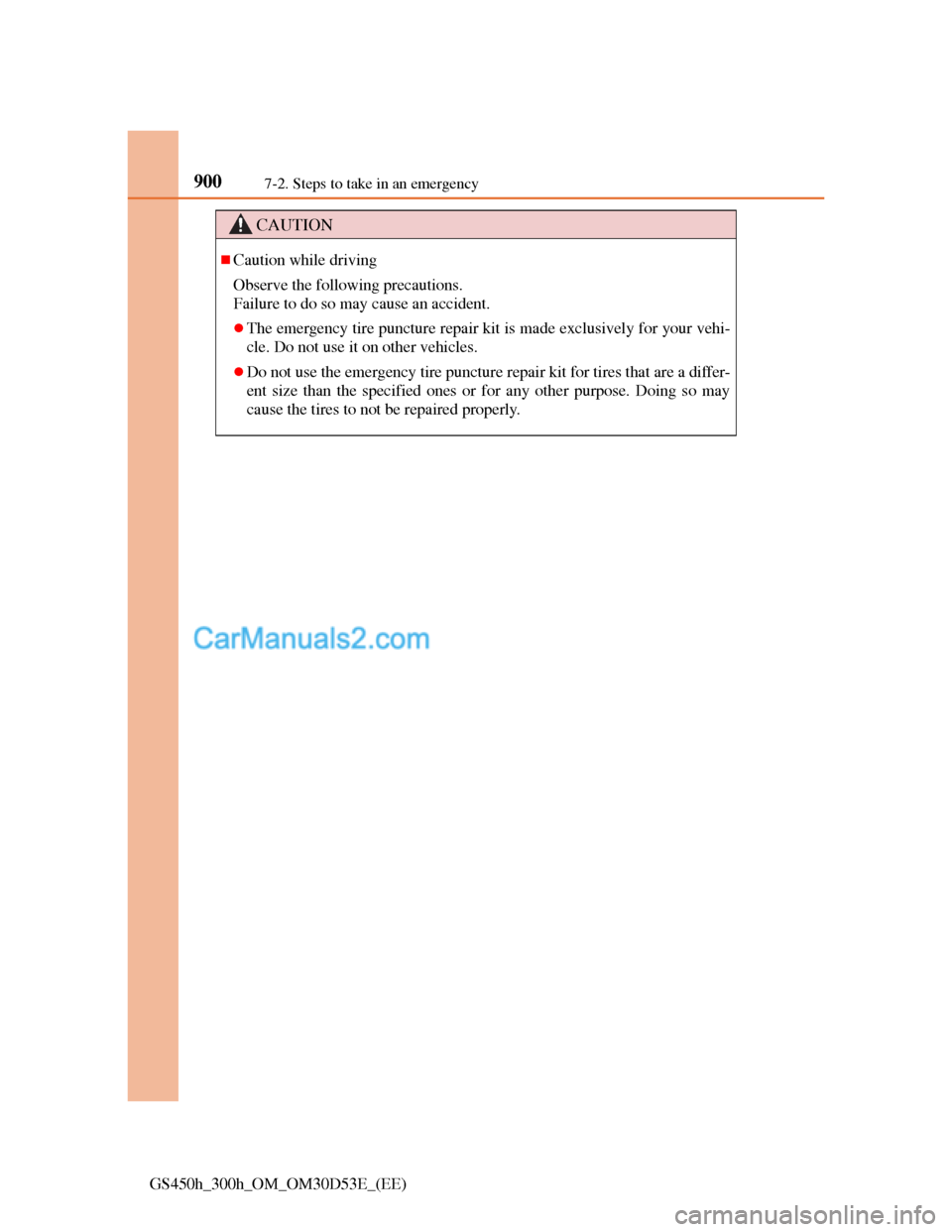
9007-2. Steps to take in an emergency
GS450h_300h_OM_OM30D53E_(EE)
CAUTION
Caution while driving
Observe the following precautions.
Failure to do so may cause an accident.
The emergency tire puncture repair kit is made exclusively for your vehi-
cle. Do not use it on other vehicles.
Do not use the emergency tire puncture repair kit for tires that are a differ-
ent size than the specified ones or for any other purpose. Doing so may
cause the tires to not be repaired properly.
Page 928 of 1014
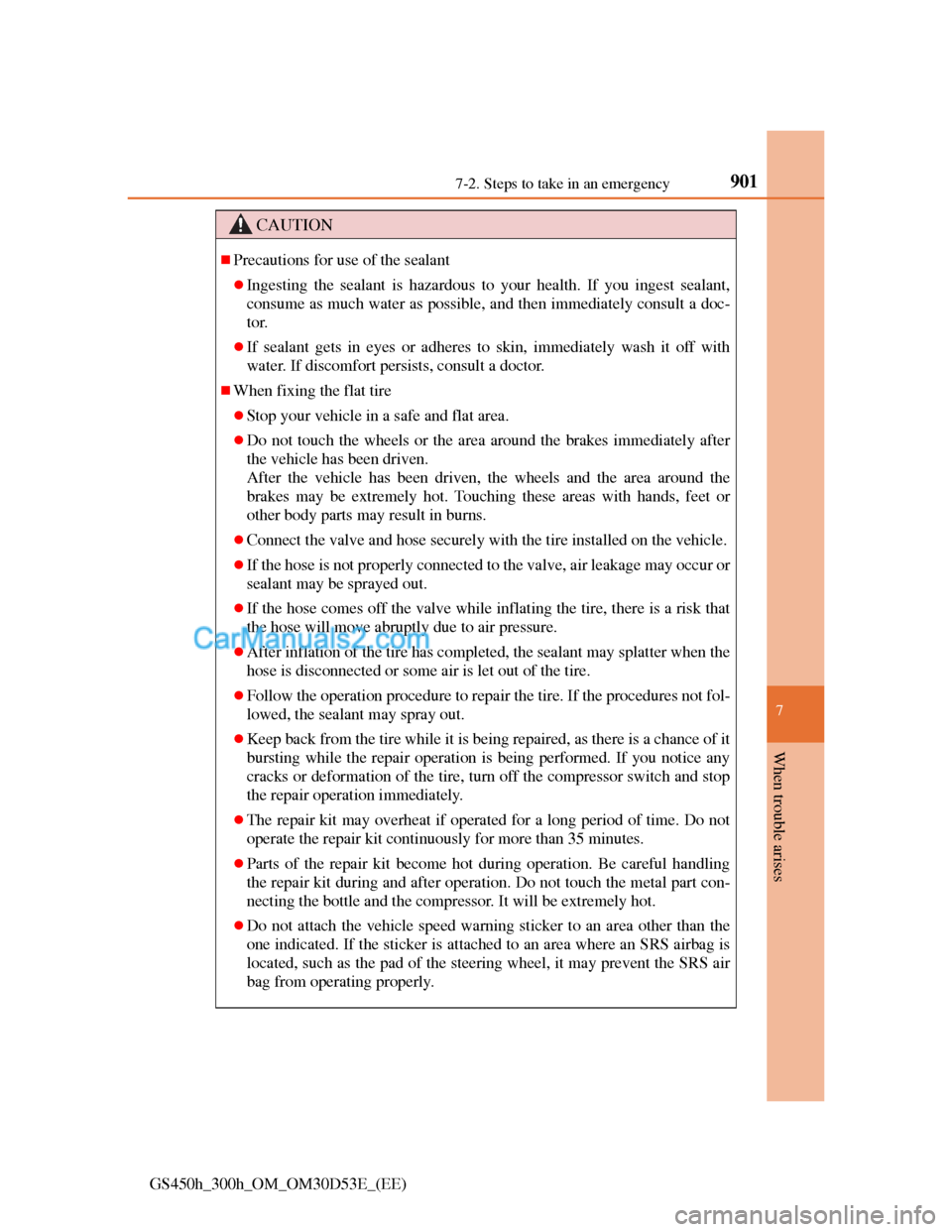
9017-2. Steps to take in an emergency
7
When trouble arises
GS450h_300h_OM_OM30D53E_(EE)
CAUTION
Precautions for use of the sealant
Ingesting the sealant is hazardous to your health. If you ingest sealant,
consume as much water as possible, and then immediately consult a doc-
tor.
If sealant gets in eyes or adheres to skin, immediately wash it off with
water. If discomfort persists, consult a doctor.
When fixing the flat tire
Stop your vehicle in a safe and flat area.
Do not touch the wheels or the area around the brakes immediately after
the vehicle has been driven.
After the vehicle has been driven, the wheels and the area around the
brakes may be extremely hot. Touching these areas with hands, feet or
other body parts may result in burns.
Connect the valve and hose securely with the tire installed on the vehicle.
If the hose is not properly connected to the valve, air leakage may occur or
sealant may be sprayed out.
If the hose comes off the valve while inflating the tire, there is a risk that
the hose will move abruptly due to air pressure.
After inflation of the tire has completed, the sealant may splatter when the
hose is disconnected or some air is let out of the tire.
Follow the operation procedure to repair the tire. If the procedures not fol-
lowed, the sealant may spray out.
Keep back from the tire while it is being repaired, as there is a chance of it
bursting while the repair operation is being performed. If you notice any
cracks or deformation of the tire, turn off the compressor switch and stop
the repair operation immediately.
The repair kit may overheat if operated for a long period of time. Do not
operate the repair kit continuously for more than 35 minutes.
Parts of the repair kit become hot during operation. Be careful handling
the repair kit during and after operation. Do not touch the metal part con-
necting the bottle and the compressor. It will be extremely hot.
Do not attach the vehicle speed warning sticker to an area other than the
one indicated. If the sticker is attached to an area where an SRS airbag is
located, such as the pad of the steering wheel, it may prevent the SRS air
bag from operating properly.
Page 929 of 1014
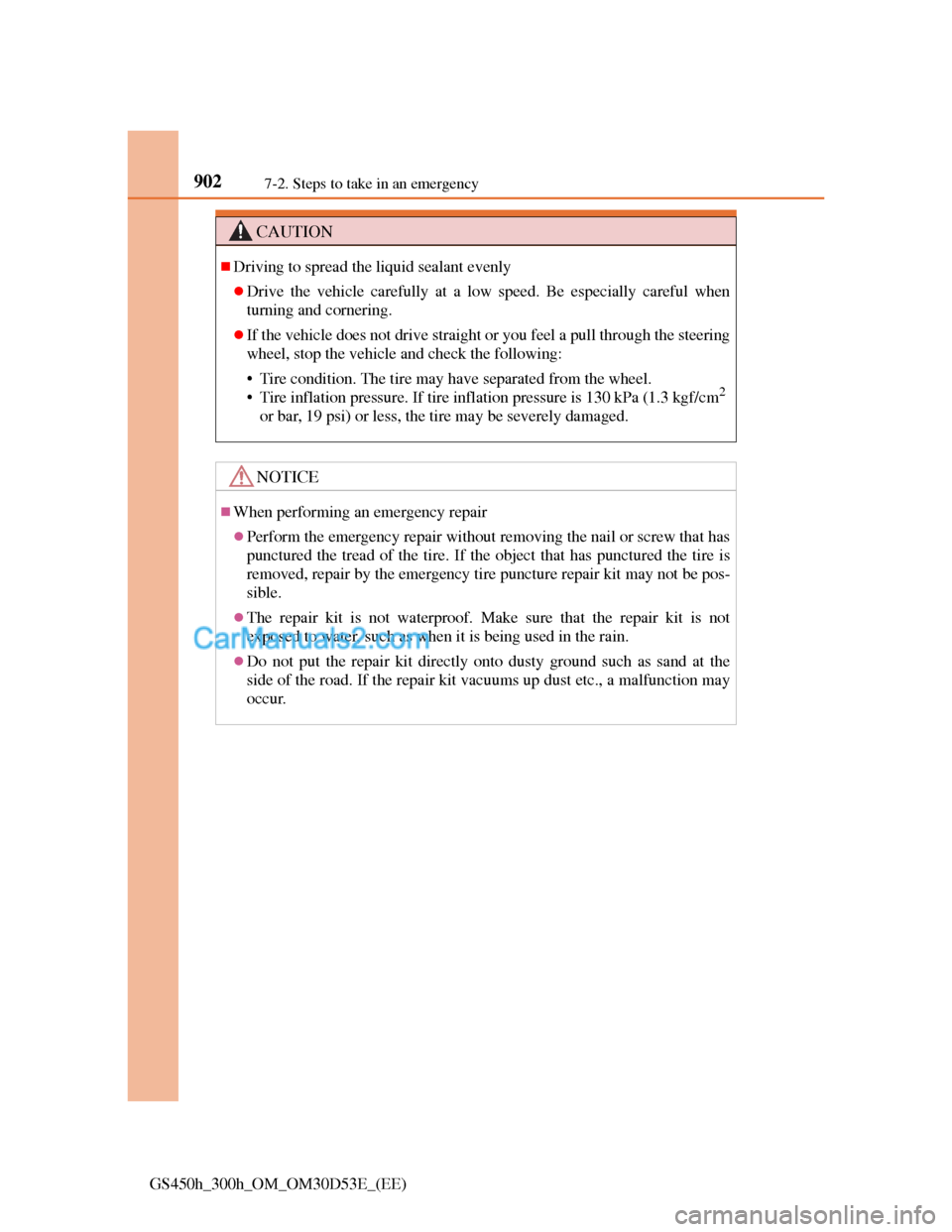
9027-2. Steps to take in an emergency
GS450h_300h_OM_OM30D53E_(EE)
CAUTION
Driving to spread the liquid sealant evenly
Drive the vehicle carefully at a low speed. Be especially careful when
turning and cornering.
If the vehicle does not drive straight or you feel a pull through the steering
wheel, stop the vehicle and check the following:
• Tire condition. The tire may have separated from the wheel.
• Tire inflation pressure. If tire inflation pressure is 130 kPa (1.3 kgf/cm
2
or bar, 19 psi) or less, the tire may be severely damaged.
NOTICE
When performing an emergency repair
Perform the emergency repair without removing the nail or screw that has
punctured the tread of the tire. If the object that has punctured the tire is
removed, repair by the emergency tire puncture repair kit may not be pos-
sible.
The repair kit is not waterproof. Make sure that the repair kit is not
exposed to water, such as when it is being used in the rain.
Do not put the repair kit directly onto dusty ground such as sand at the
side of the road. If the repair kit vacuums up dust etc., a malfunction may
occur.
Page 930 of 1014
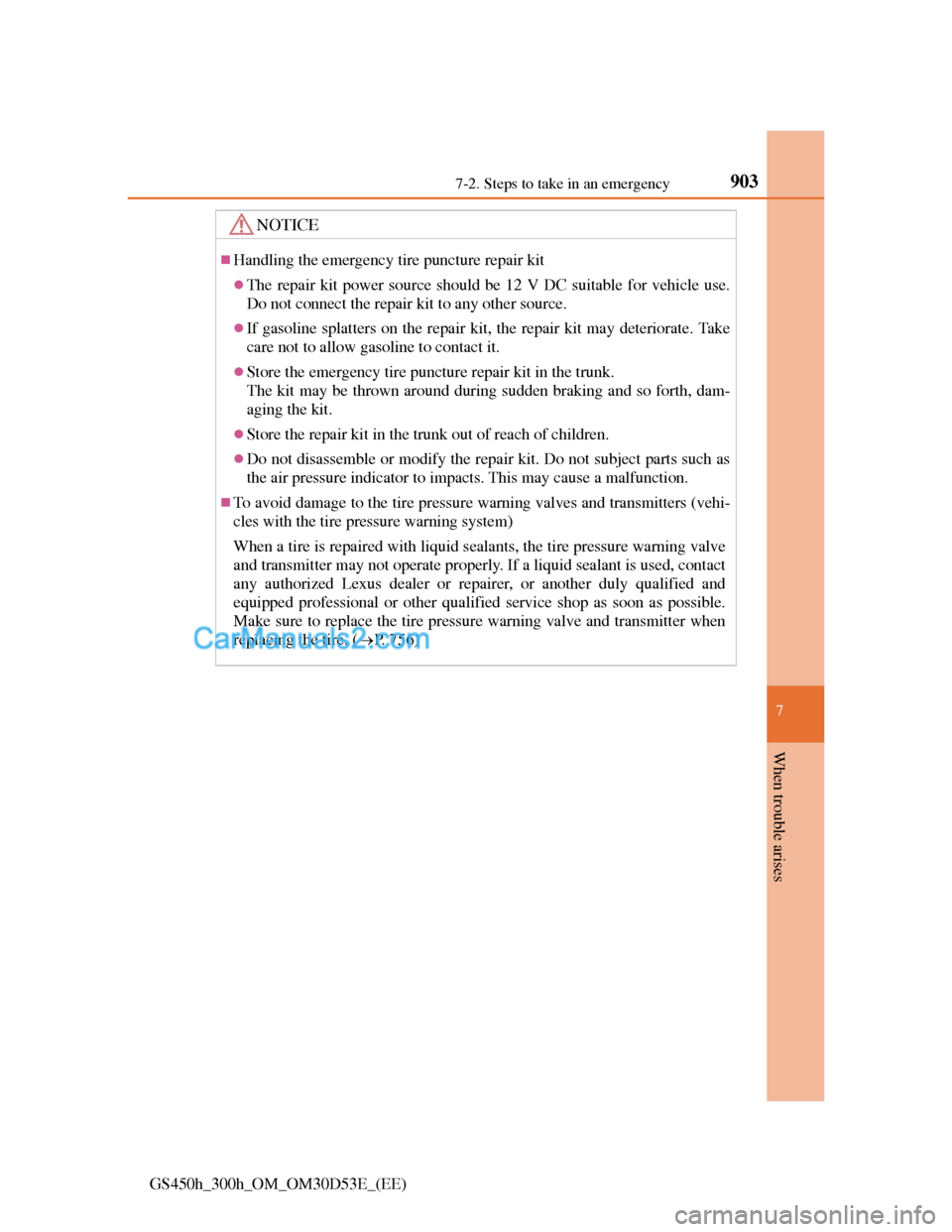
9037-2. Steps to take in an emergency
7
When trouble arises
GS450h_300h_OM_OM30D53E_(EE)
NOTICE
Handling the emergency tire puncture repair kit
The repair kit power source should be 12 V DC suitable for vehicle use.
Do not connect the repair kit to any other source.
If gasoline splatters on the repair kit, the repair kit may deteriorate. Take
care not to allow gasoline to contact it.
Store the emergency tire puncture repair kit in the trunk.
The kit may be thrown around during sudden braking and so forth, dam-
aging the kit.
Store the repair kit in the trunk out of reach of children.
Do not disassemble or modify the repair kit. Do not subject parts such as
the air pressure indicator to impacts. This may cause a malfunction.
To avoid damage to the tire pressure warning valves and transmitters (vehi-
cles with the tire pressure warning system)
When a tire is repaired with liquid sealants, the tire pressure warning valve
and transmitter may not operate properly. If a liquid sealant is used, contact
any authorized Lexus dealer or repairer, or another duly qualified and
equipped professional or other qualified service shop as soon as possible.
Make sure to replace the tire pressure warning valve and transmitter when
replacing the tire. (P. 756)